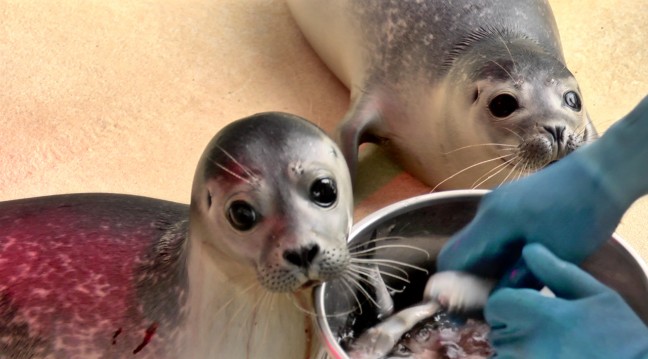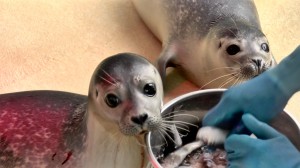Wildlife: Seal Pub Rescue and Release
This short documentary is available in 2 languages, German and English.
Wildlife: Seal Pub Rescue and Release

This short documentary illustrates the work of the seal pub rescue station in Norden-Norddeich. It is an environmentally educational film related to Marine Wildlife and Germanys Lower Saxony Wadden Sea National Park, which has been acknowledged since 2009 as UNESCO World Natural Heritage. This film is available in English and German language.
Transcription
The seal pub rescue station in Norden-Norddeich exists since 40 years, we have our 40th anniversary this year – a couple of hunters, especially Winhold Schuhmann and Erwin Manninger, were looking for a solution on how to deal with these small seal pubs during the summer months, which are washed up here at our beaches and the idea came up to create this seal pub rescue station.
This went very well and in 1980, the station relocated here to Norddeich – here we are very close to the North Sea, and we can utilize sea water for our basins. Since 1980 this station grew very well and four years ago we have again enhanced our basins to meet our requirements as well those of the veterinarians.
I am 44 years old, and had studied science of forestry in Göttingen with a focus on Wildlife Biology and I always wanted to conduct research about marine mammals. I am working here since 12 years and since then we support and help our see pubs.
This station is responsible for the complete cost line of lower Saxony with the Lower Saxony Wadden Sea National Park as the biggest component, which has been acknowledged since 2009 as UNESCO World Natural Heritage. In this area we have coastal islands, the mud flat area and the dykes on the mainland. Seal pubs have adopted this area and have managed to accommodate these difficult conditions related to the tides – and every summer the young animals are borne on these temporarily dried up sandbanks. Already 6 hours later they need to swim behind the mother. During the lactation period of 4 to 6 weeks they are only parented by the mother and need to triple their weight. There are many reasons why these young animals have problems. Common problems are thunder storms, heavy storms, in particular the once from northwest, because they create big floods, which decreases the available for lactation. A big problem and focus of our work is the human being. Many people like to visit this wadden sea, such as vacationers, surfer and boat lovers and this causes unfortunately many disturbances in the wadden sea . During lactation a seal mother needs to lie on its side and during a disturbance changes the position to its stomach in order to raise the head. This means lactation is interrupted. If the disturbance is severe the seal mother needs to escape and during the worst case scenario, the seal baby needs to escape as well and loses energy instead of gaining energy. These animals are at risk to become a howling seal pub because during the next stronger storm the energy required to follow the mother is missing. Seal milk consists of 50% grease, which demonstrates that during a tidal phase this energy is really necessary. We are only patrolling along the dykes on the mainland and the northern side of the islands. If we encounter a young animal, which is separated from its mother, than we observe it for some time in order to find out if the mother is close by. If this isn’t the case then our governmentally appointed supervisor check the animals at a closer distance if they are injured and how its overall condition looks like and if it is dehydrated or even apathetic than we take it to our seal rescue station here at Norddeich.
We have in our seal pub rescue station more than 60 animals, which means that they are quite hungry, and we need quite a bit of fish here, we feed herrings, which are delivered in 32 kg frozen blocks. – So the fish is frozen directly on sea, which assures that our fish is very fresh. Seals are not scavenging animals so we therefore need extremely fresh fish in order that the animals eat it. We only feed dead fish – we don’t need to feat living fish because seals have a hunting instinct – so once we release them they will grab by the use of their instinct anything what they see, the fish is probably initially not that big as our once her but they probably eat snales, crawfishes and shrimps, until they hunt for bigger fishes. We feed every day about 3 kg fish for every animal, this is quite a big amount for our seal pubs, because they are just a few weeks old – We feed much more than they need in order that they have the fat reserves necessary once they are released. Before seal pubs are released they should have a weight of about 25 – 30 kg, which is 5 to 10 kg more than wild seal pubs of similar age. They have therefore one to two weeks time to get used to their new environment before they are required to look for food.
The first few days the howling seal pubs enter the quarantine room. We conduct a medical examination, stabilize the animal with electrolytes and examine the blood – this is very important because we need to assure that we don’t catch any diseases. If everything is fine the animal is delivered to our station after 6-7 days and after 70 to 80 days it gained the same weight than its wild members of the same species – and then we can release them.
A howling seal pub is a young animal separated from its mother. Normally, many puppies swim with their mothers outside – only once it is separated from its mother it tries with a distinct sorrow scream to call its mother, and basically says I am hungry and I am looking for you. Usually these young animals look for their mother for a couple of days and the screaming become more intense. Normally, visitors become active and call us stating that there is an howling seal pub and our volunteers take care that professional support is provided.
The number of animals in our station is variable and depend on the actual stock in our Wadden Sea. In 2011 we counted 7416 animals, so this are all our seal pubs, an we conduct on a regular basis flights with the objective to count our animals, – we have approximately 1600 young animals and unfortunately some become the howling once – in our station we have between 30 and during this year 101 animals which we take care of and are going to release at the end of this season.
This station is solely funded by the entry fees and donations. We depend on these donations. We are one of the most frequented environmental education institution here at the coast line with more than 200 thousand visitors here at the seal rescue station and more than 50 thousand visitors at our Waloseum, where the quarantine station is located as well – and only with the help of our visitors we are able to finance this station.
A really nice aspect of our work is the time once the seal pubs are released. Sometimes people ask us if we are not sad if they disappear within the water. But strictly speaking we have two laughing eyes because these animals are only here for a short and limited amount of time, the fewer animals we have and the shorter the time frame here at our station, the better.
We consider us as a multiplier – every visitor is educated on how to behave once they encounter a seal. The most important thing is that they leave them alone, keep a certain distance, 300 meter is an optimum, but often people don’t realize this distance, if you are to close to a seal than the mother runs away, it is also important to inform other visitors that they maintain the distance necessary. Dogs must be kept on the leash, and then seal pubs have a chance not to become a howling seal pub, this is our massage to all of our visitors. We also conduct sea voyages in order to educate our visitors about seal and how to provide help and support. These are the main aspects about our environmental education. We look after 1200 groups every year and we hope that many of them know what to do in case they find a seal.
Seals have been chased because they can be commercially utilized. The skin had been used for clothes, the grease for oil lamps or ointments – so there are many ways on how to use seals commercially but nowadays all these items can be produced by chemical means, synthetic fiber can also be used for clothes, so there isn’t a commercial need to chase seals anymore. In particular on the islands some families made a living from seal hunting but this was during the 19th century and after the industrialization there wasn’t a need anymore.
At the end of the 60ths and the beginning of the 70th or seal stock was very unstable. So our station was build 1971 and since 1972/73 seal hunting has been prohibited. However, it had taken about 10 years until the seal stock recovered. We assume that waste dumping into the sea as well as DDT entries had been responsible for this. After this had also been prohibited and the water quality increased significantly, the amount of fish also increased, the seal population increased. In 1988 harp seals, which originated from the Polar Sea, the PDV-Virus had been introduced and about 50% of the population died. We had 2500 before and 1500 after the distemper. 2002 we counted 6500 animals but again, this time it was the Hooded Seal, also from the Polar Sea, introduced another virus and 4000 animals died. Since then the population increased and today we have 7400 animals.
We always see that these animals are perfectly adapted to our environment. One of my most beautiful experiences I had once we released a horse head seal close to Norderney, it dived close to the sandbank just once and came up with a common sole in the mouth – so we see these animals are in a good shape, they have a hunting instinct, and this was the most enjoy full experience we had.
Credits
A short documentary by Guido Nageldinger. A Production by Nageldinger Film ( http://www.nageldinger-film.de/ ) in collaboration with Seal Sanctuary in Norden-Norddeich, Germany ( http://www.seehundstation-norddeich.de/ )
Released Seal Pubs
Vreni
initial weight 10,2 kg
weight on release 30,2 kg
Niko
initial weight 9,8 kg
weight on release 28,4 kg
Nele
initial weight t 9,2 kg
weight on release 29,6 kg
Imke
initial weight 12 kg
weight on release 28,2 kg
Camera, Postproduction & English VO
Guido Nageldinger PhD
Head of Seal Sanctuary/Whale Museum
Dr. Peter Lienau, Dipl.-Forstwirt
Animal Caretakers
Fritz Rabenstein
Tim Fetting
Music
“Calm Piano and Guitar Instrumental”
by Salem De Bezenac
Publisher iStockphoto
SFX
“Seashore – waves and gulls” by Erik Normark
“Whale Song” by Micky Wiswedel
Publisher iStockphoto
Production
Nageldinger Film
in collaboration with
Seal Sanctuary in Norden-Norddeich, Germany
(c) 2011 Nageldinger Film

